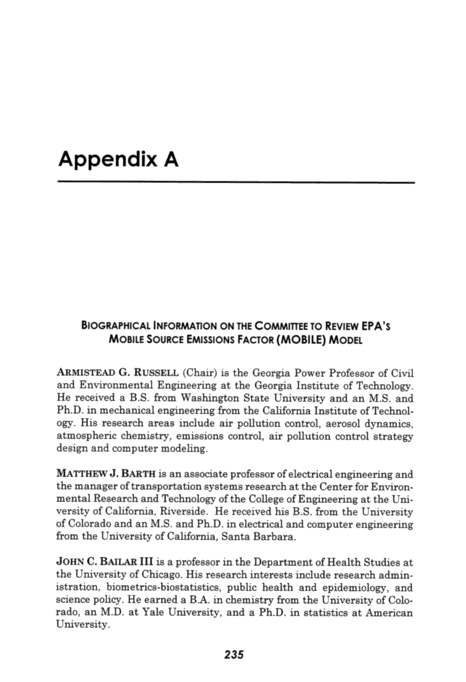


Below is the uncorrected machine-read text of this chapter, intended to provide our own search engines and external engines with highly rich, chapter-representative searchable text of each book. Because it is UNCORRECTED material, please consider the following text as a useful but insufficient proxy for the authoritative book pages.
Appendix A BIOGRAPHICAL INFORMATION ON THE COMMITTEE TO REVIEW EPA'S MOBILE SOURCE EMISSIONS FACTOR (MOBILE] MODEL ARMISTEAD G. RUSSELL (Chair) is the Georgia Power Professor of Civil and Environmental Engineering at the Georgia Institute of Technology. He received a B.S. from Washington State University and an M.S. and Ph.D. in mechanical engineering from the California Institute of Technol- ogy. His research areas include air pollution control, aerosol dynamics, atmospheric chemistry, emissions control, air pollution control strategy design and computer modeling. MATTHEW J. BARTH is an associate professor of electrical engineering and the manager of transportation systems research at the Center for Environ- mental Research and Technology of the College of Engineering at the Uni- versity of California, Riverside. He received his B.S. from the University of Colorado and an M.S. and Ph.D. in electrical and computer engineering from the University of California, Santa Barbara. JOHN C. BAILAR IIT is a professor in the Department of Health Studies at the University of Chicago. His research interests include research admin- istration, biometrics-biostatistics, public health and epidemiology, and science policy. He earned a B.A. in chemistry from the University of Colo- rado, an M.D. at Yale University, and a Ph.D. in statistics at American University. 235
236 MODEIJNG MOBI1E-SOURCE EMISSIONS LAURENCE S. CARETTO is dean of the College of Engineering and Com- puter Science at California State University, Northridge (CSUN). He re- ceived his Ph.D. in engineering from the University of California, Los An- geles. CARLETON J. HOWARD is a research chemist for the Aeronomy Lab of the National Oceanic and Atmospheric Administration in Boulder, Colorado. He received his Ph.D. in physical chemistry from the University of Pitts- burgh. He conducts research in atmospheric chemistry including labora- tory studies of the kinetics of the gas reactions of atoms, radicals, and ions with small molecules. JOHN H. JOHNSON is a presidential professor of mechanical engineering at Michigan Technological University. He received his Ph.D. from the Univer- sity of Wisconsin-Madison and is a fellow member of the Society of Auto- motive Engineers. His research involves developing diesel particulate emissions measurement and control systems, methods for determining the effectiveness for diesel particulate and gaseous emissions control systems in underground mines, and a vehicle engine cooling system simulation model. JOHN F. KOWALCZYK recently retired as manager of the air quality plan- ning division of the Oregon Department of Air Quality. He received his M.S. in environmental engineering from Oregon State University. ALAN C. LLOYD is chairman of the California Air Resources Board. Previ- ously, he served as executive director of the Energy and Environmental Engineering Center at the Desert Research Institute. His research inter- ests involve alternative fuels, renewable energy and advanced technolo- gies. He received his Ph.D. in gas kinetics from University College of Wales, Aberystwyth. MICHAEL R. MORRIS is director of transportation for the North Central Texas Council of Governments. He is responsible for providing travel in- put data to the MOBILE model as well as using the MOBILE model to meet EPA's transportation conformity requirements. He holds a master's degree in civil engineering from the State University of New York at Buf- falo and is a licensed professional engineer. ALISON K. POLLACK is a principal at ENVIRON Corporation, an environ- mental consulting firm. She received her M.S. in statistics from the Uni- versity of Wisconsin-Madison. Her work is in the analysis of mobile source emissions and emissions models, mobile source control program evalua-
APPENDIX A 237 tion, emissions and air quality evaluation of alternative and reformulated fuels, and environmental statistics. ROBERT F. SAWYER is a professor emeritus with the Department of Me- chanical Engineering at the University of California, Berkeley. He con- ducts research in engine combustion, pollutant formation and control, toxic waster incineration, and alternative fuels. He received his Ph.D. from the Department of Aerospace Sciences at Princeton University.
